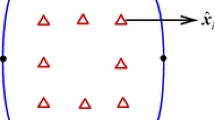Abstract
The ideal boundary of a discontinuity is defined as that boundary along which there is no stress concentration. Photoelastically an isochromatic coincides with the ideal boundary. This property is used to develop experimentally ideal boundaries for some cases of technological interest. The concept of ‘coefficient of efficiency’ is introduced to evaluate the degree of optimization. The procedure to idealize boundaries is illustrated for the two cases of the circular tube and of the perforated rectangular plate, with prescribed functional restraints and a particular criterion for failure. An ideal design of the inside boundary of the tube is developed which decreases its maximum stress by 25 percent, at the time it also decreases its weight by 10 percent. The efficiency coefficient is increased from 0.59 to 0.95. Tests with a brittle material show an increase in strength of 20 percent. An ideal design of the boundary of the hole in the plate reduces the maximum stresses by 26 percent and increases the coefficient of efficiency from 0.54 to 0.90.
Similar content being viewed by others
References
Kirsch, B., “Theory of Elasticity and Requirements of Strength of Materials,”Zeits, Ver. Deut. Ing.,42,799 (1898).
Peterson, R.E., Stress Concentration Factors, Wiley (1974).
Roark, R.J. and Young, W.C., “Formulas for Stress and Strain,” 5th Ed., McGraw-Hill (1975).
Richmond, W.O., Discussion of R.D. Mindlin's paper “Stress Distribution Around a Tunnel,” Proc. ASCE, 1465–1467 (Oct. 1939).
Berkey, D.C., “Reducing Stress Concentration with Elliptical Fillets,”Proc. SESA,1 (2),56–60 (1944).
Baud, R.V., “Beitrage zur Kenntnis der Spannungsverteilung in Prismatischen und Keilfoermigen Konstruktionselementen mit Querschnitteubergaengen.,” Eidg., Materialpruef. Ber., Zuerich,83 (1934).
Lansard, R., “Fillets Without Stress Concentration,”Proc. SESA,XIII, (1),97–104 (1955).
Peterson, R.E., Stress Concentration Factors, Wiley, 2 (1974).
Kuske, A., “Einfuehrung in die Spannungsoptik,”Wiss. Verlag, Stuttgart (1959).
Heywood, R.B., Designing by Photoelasticity, Chapman and Hall (1952).
Heywood, R.B., Photoelasticity for Designers, Pergamon, Ch. 11 (1969).
Durelli, A.J. and Riley, W.F., Introduction to Photomechanics, Prentice Hall, 228 (1965).
Durelli, A.J., “Experimental Strain and Stress Analysis of Solid Propellant Rocket Motors,” Mech. and Chem. of Solid Propellants, Pergamon, 381–442 (1967).
Durelli, A.J., Dally, J.W. andRiley, W.F., “Stress and Strength Studies on Turbine Blade Attachments,”Proc. SESA,XVI (1),171–182 (1957).
Durelli, A.J., Parks, V.J. andUribe, S., “Optimization of a Slot End Configuration in a Finite Plate Subjected to Uniformly Distributed Load,”J. Appl. Mech.,35 (2),403–406 (Jun. 1968).
Francavilla, A., Ramakrishnan, C.V. andZienkiewiez, O.C., “Optimization of Shape to Minimize Stress Concentration,”J. Strain Anal.,10 (2),63–70 (1976).
Thum, A. andSvenson, O., “Beanspruchung bei mehrfacher Kerkwirkung. Entlastung-und Ueberlastungskerben,”Schweizer Archiv für Ang. Wiss und Tech.,15 (6),161–174 (Jun. 1949).
Durelli, A.J., Lake, R.L. andPhillips, E., “Stress Concentrations Produced by Multiple Semi-circular Notches in Infinite Plates under Uniaxial State of Stress,”Proc. SESA,X (1),53–64 (1952).
Durelli, A.J., Lake, R.L. and Phillips, E., “Stress Distribution in Plates under a Uniaxial State of Stress, with Multiple Semi-circular and Flat-bottom Notches,” Proc. 1st U.S. Natl. Cong. Appl. Mech., 309–315 (1952).
Erickson, P.E. andRiley, W.F., “Minimizing Stress Concentrations Around Circular Holes in Uniaxially Loaded Plates,”Experimental Mechanics,18 (3),97–100 (Mar. 1978).
Durelli, A.J. and Parks, V.J., Moiré Analysis of Strain, Prentice Hall (1970).
Author information
Authors and Affiliations
Rights and permissions
About this article
Cite this article
Durelli, A.J., Brown, K. & Yee, P. Optimization of geometric discontinuities in stress fields. Experimental Mechanics 18, 303–308 (1978). https://doi.org/10.1007/BF02324161
Received:
Issue Date:
DOI: https://doi.org/10.1007/BF02324161




